Not all content needs to be shared everywhere. And not all content is suitable for every social media platforms.
It’s all right to post entirely different things on different platforms. In fact, it might even help you to boost your engagement.
For example, if you take a look at our Twitter and Instagram accounts, you’ll notice that we post entirely different things on each platform.
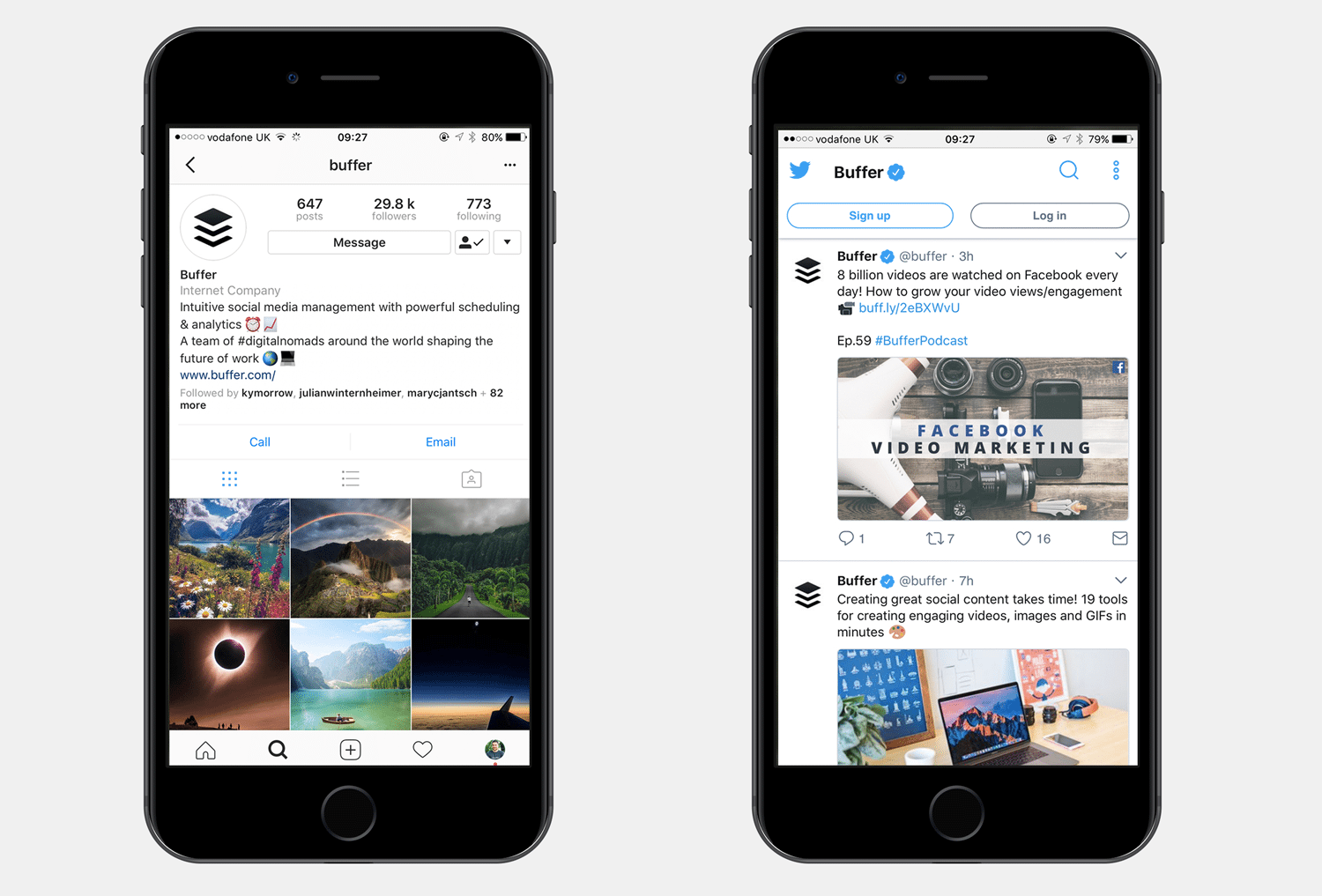
But how do you decide what to post on each social media platform?
To help you with your social media marketing strategy, we would love to share some suggestions and examples that have worked for us and others.
By the end of this post, we hope you’ll know exactly what to share on each of your social media profiles.
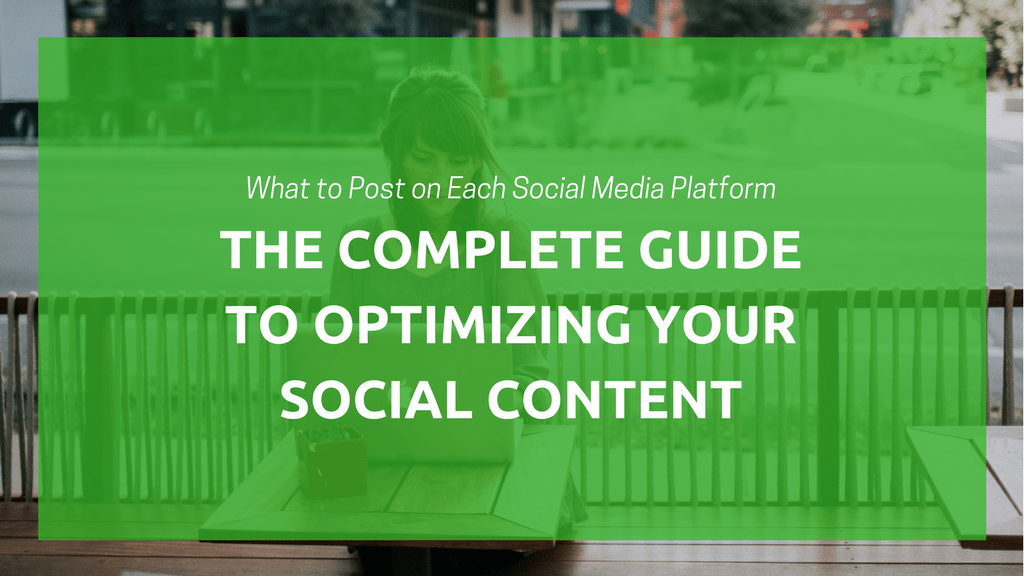
What to post on each social media platform
Every platform has its own audience. And each audience has their own expectations for the things they want to see on the platform – that can affect how well your social media posts perform.
Since every platform is different, this guide will cover each of the following six major social media platforms separately.
Here are the general guidelines:
Facebook: Videos and curated content
Instagram: High-res photos, quotes, Stories
Twitter: News, blog posts, and GIFs
LinkedIn: Jobs, company news, and professional content
Pinterest: Infographics and step-by-step photo guides
Once you’ve decided on what to post to each social media platform, we would love to help you craft the perfect post for every social platform in one seamless experience.
GET STARTED WITH BUFFER TAILORED POSTS >>>
What to post on Facebook
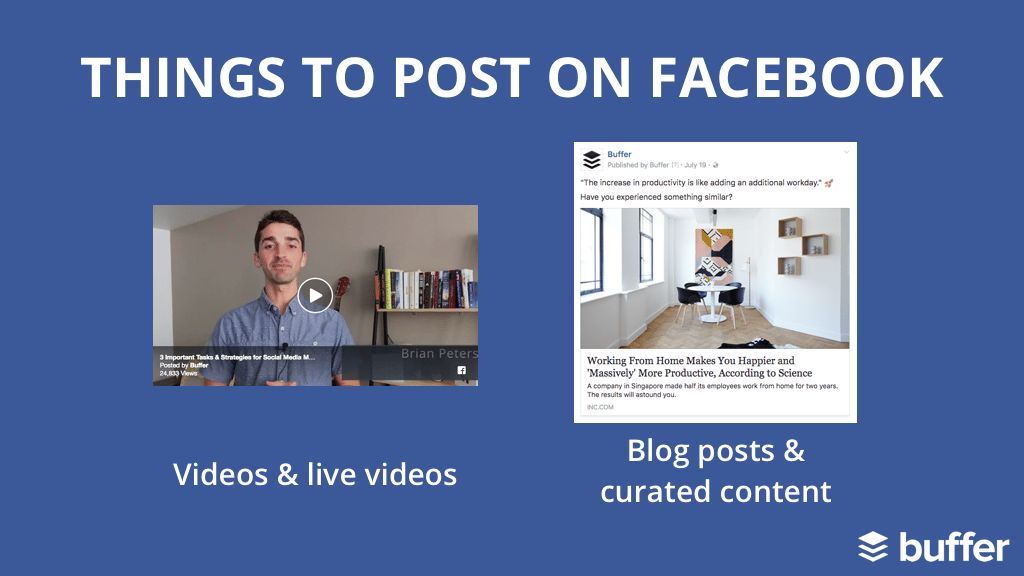
Videos and live videos
Our goal on Facebook has been to build our brand and engage our fans.
Recently, videos and live videos have proven to be the best types of content for our Facebook Page.
Our video posts generated the highest average reach among all post types. The average engagement on our video posts is almost on par with that on our photo posts, which have the highest average engagement.
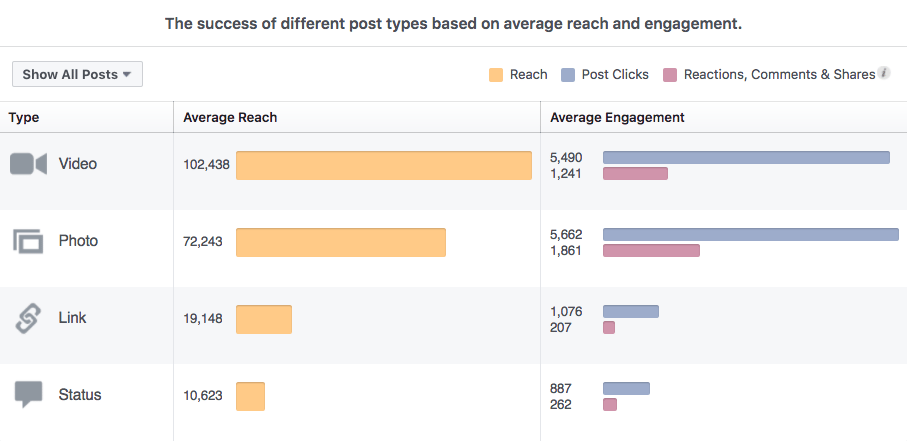
Buzzsumo analyzed 68 million Facebook posts and found that a similar trend: videos have higher average engagement than images and links.
We focus on creating educational videos for our Facebook Page:
- How-to guides: These are videos where Brian Peters, our Digital Marketing Strategist, share social media tips and tricks.
- Blog post summaries: For these videos, we summarize the key ideas from our blog posts and turn them into short video clips using Animoto.
Here’s an example of a Facebook video that has done well for us recently:
TIP:
Upload your videos to Facebook directly. Such videos receive more engagement and shares than YouTube links, according to a quintly study.
Blog posts and curated content
After videos, blog posts and curated content are the next types of posts that do well on our Facebook Page.
Apart from sharing our blog posts, we also curate high-quality (proven) content from third-party Pages and sites. This Facebook posting strategy has helped us grow our Facebook Page’s reach, engagement, and Likes over the past year.
Our Page Likes grew by over 40 percent over the past year.

We have found posts that are both educational and entertaining do the best for us on Facebook. Here’s a recent example:
TIP:
A great way to find high-quality content is to use the Facebook feature, Pages to Watch. Here’s a video tutorial on where to find it and how it works.

What to post on Instagram
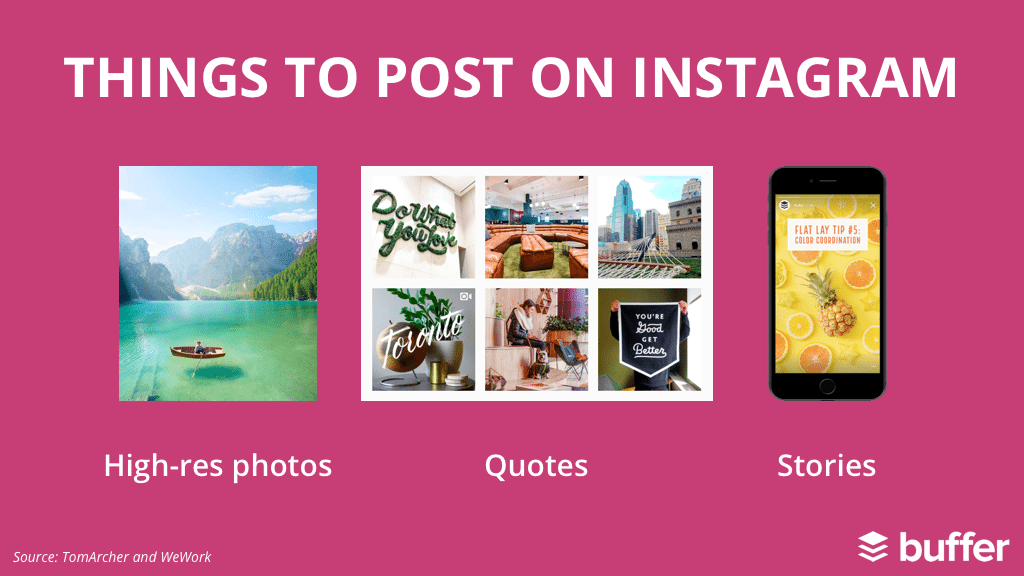
High-res photos
Instagram has become a place where people post only the best photos (and videos) on their profile.
After interviewing and surveying 11,000 13 to 24-year-olds around the world, Facebook recommends marketers to “blend in to stand out”:
Instagrammers appreciate aesthetic quality in visual content and will often make the effort to transform the banal into a thing of beauty. Brands seeking to engage teens and young adults will want to offer an organic experience by aiming for quality, too. Images and video will ideally be beautiful, thoughtfully composed and artfully presented.
Here are a few types of high-quality photos you can post to Instagram:
Product photos: If you sell physical products such as fashion or food, you can post high-resolution photos of your product in various settings. Califia Farms (@califiafarms) does a great job with this. (See more examples here from the best brands on Instagram, according to HubSpot.)
Behind-the-scenes: Another popular type of Instagram photos from brands are behind-the-scenes photos. These could be photos of people in the company, events, or the making of a product (e.g. how a dish is prepared).
User-generated content: If you can’t get suitable product photos or enough behind-the-scenes photos like us (a remote company that creates software), you could post user-generated content. User-generated content grew our Instagram account by over 500 percent in a year.
TIP:
While curating amazing user-generated content for your Instagram account, be sure to request permission from the original poster before re-posting it.
Quotes
Motivational and inspirational quotes are one of the most popular content types on Instagram (with more than 42 million posts tagged with #quotes at the time of writing).
A brand that does a great job (creatively) integrating quote posts into their Instagram profile is WeWork (@wework).

If you are unable to get such photos with quotes, you can also create graphics with quotes using free design tools like Canva and Adobe Spark.
For example, Kelli Pease (@happster) grew her side project, The Happster, a blog about happiness, to nearly a 100,000 followers, with most graphics with quotes.
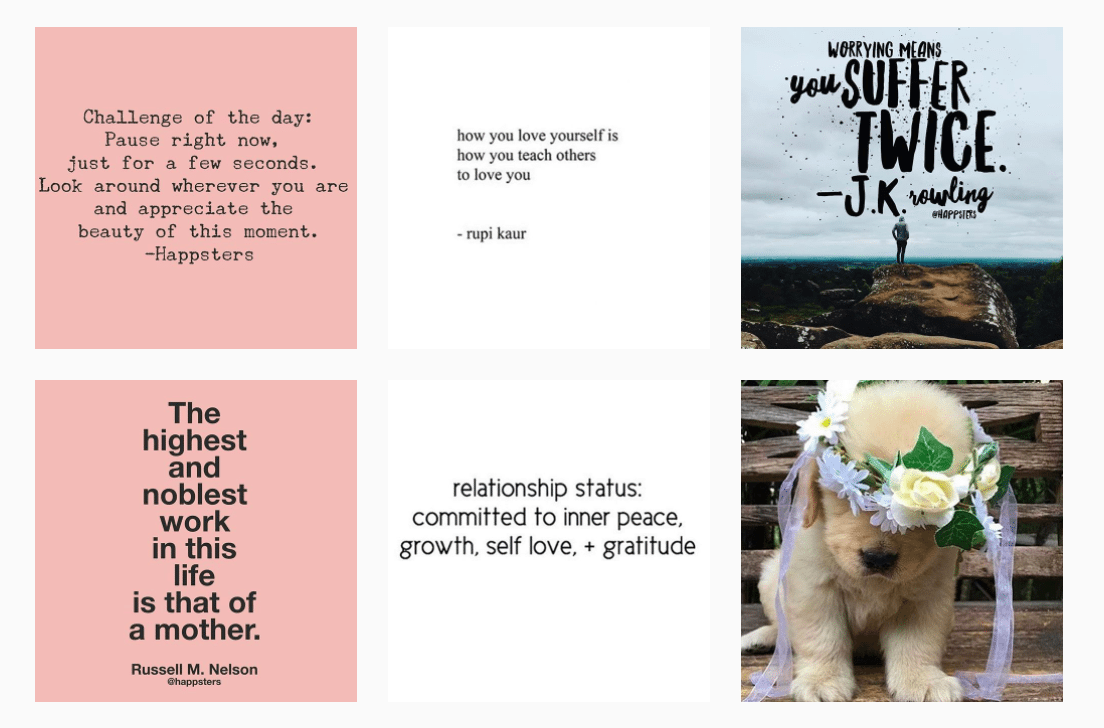
TIPS:
Here are three tips from Andrew Hutchinson of Social Media Today for getting the most out of your quote posts:
— Seek out the best quotes which support your brand mission
— Use your own images where possible
— Don’t go overboard
Stories
While it’s important to Instagram Stories for your marketing. Here are a few examples:
- Storytelling
- Share how-to tutorials
- Promote a blog post
- Share a list
- Announce limited time offers and promotions
- Offer giveaways and discount coupons
- Share data, research, and statistics
- Share quotes and inspiration
- Introduce an Instagram takeover guest
- Share announcements, news, and updates
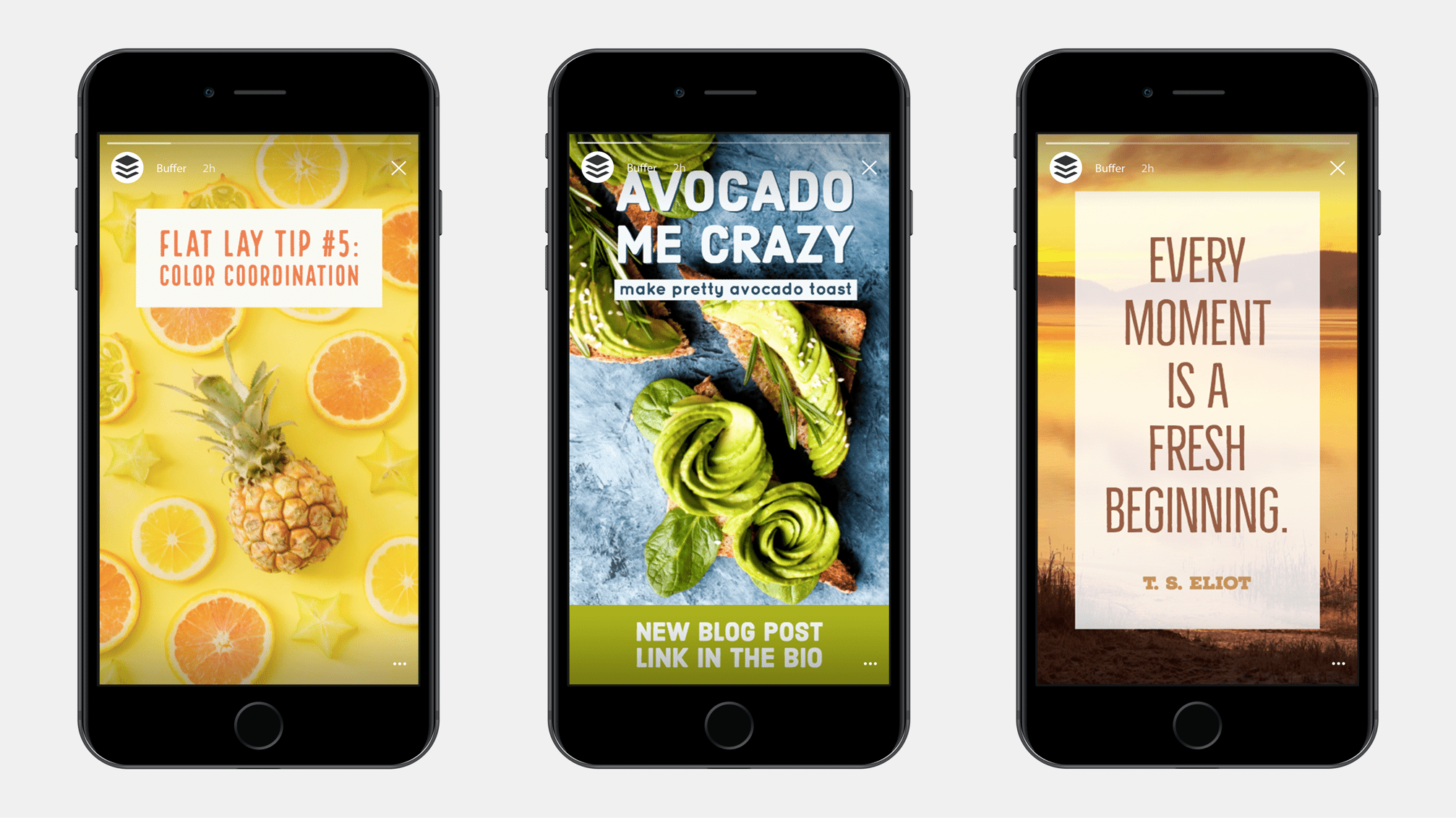
While sharing your Instagram Stories, remember to keep them in line with your Instagram marketing strategy.
TIP:
A fast way to create great-looking Instagram Stories is to start with a template. Here are 10 free customizable Instagram Stories templates you can use.

What to post on Twitter
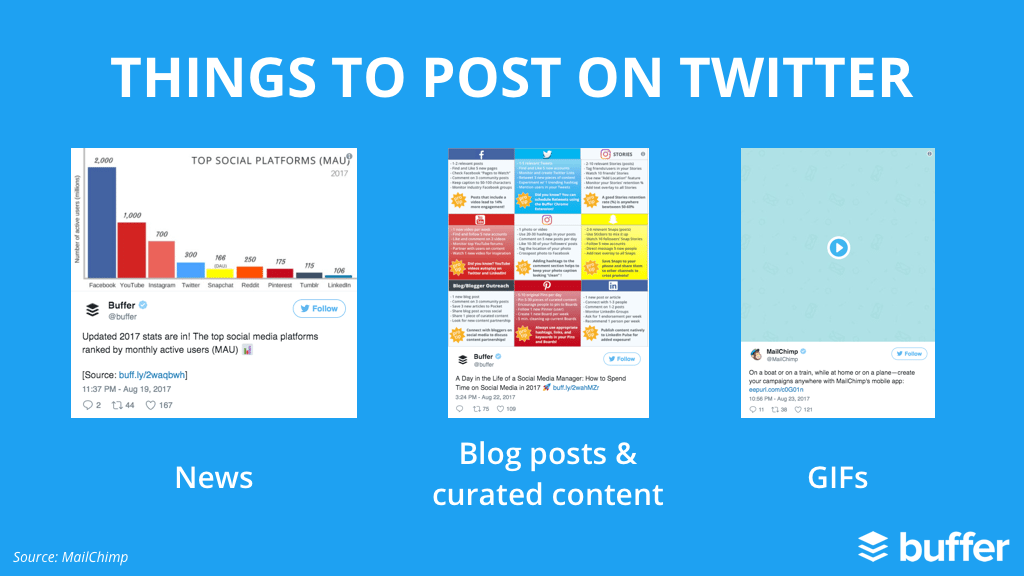
News
The most common reason why people use Twitter is to keep up with news, according to a survey of over 3,000 people by the American Press Institute.
40 percent use Twitter to find out about breaking news; 39 percent to keep up with news in general.
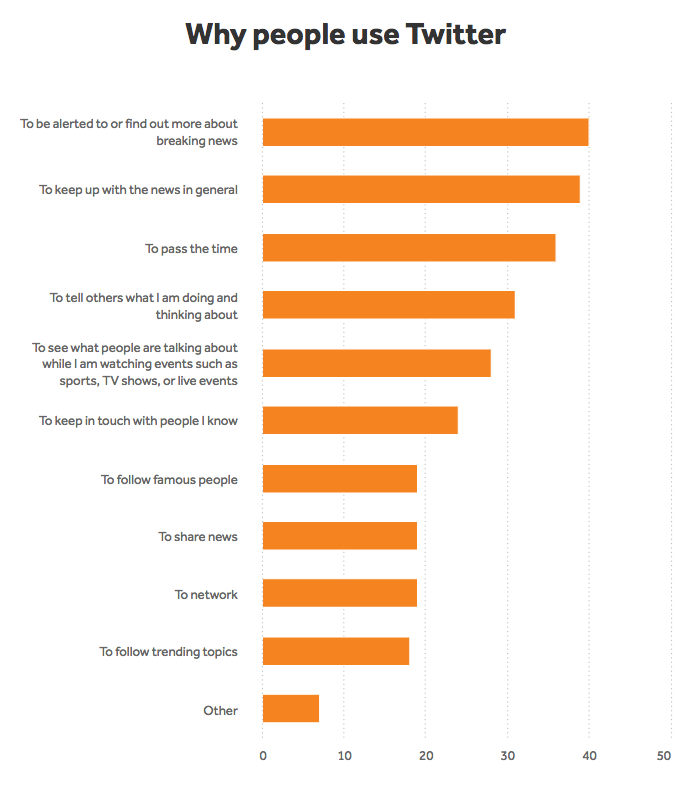
This makes it a great platform for sharing news relevant to your followers — industry news, company news, product news.
Here’s an example of industry news we share on Twitter:
Updated 2017 stats are in! The top social media platforms ranked by monthly active users (MAU) ?
[Source: https://t.co/GoiaYRlP3q] pic.twitter.com/z9Cwgk3Ozs
— Buffer (@buffer) August 19, 2017
TIP:
Feedly is a great RSS reader for keeping up with news in your industry. Here’s how I use Feedly for Blog posts and curated content
Because people and brands tend to tweet many times a day, it’s more suitable to share several blog posts or pieces of curated content per day on Twitter than other platforms like Facebook.
When we schedule tweets about our blog posts, we like to add one of the following multimedia attachments to keep the tweet interesting to our followers:
- Link (with the link preview)
- Photo or infographic
- Video
- GIF
Here’s an example:
A Day in the Life of a Social Media Manager: How to Spend Time on Social Media in 2017 ? https://t.co/OiCUDKtTHz pic.twitter.com/BwORxwQavt
— Buffer (@buffer) August 22, 2017
TIP:
Experiment with videos. Just like on our Facebook Page, our Twitter followers have been liking our videos.
The maximum length of a Twitter video is 140 seconds (or two minutes and 20 seconds). You can find GIFs
For example, when MailChimp launched a new feature in their mobile app, they made a GIF to show how easy it is to create email campaigns on the go.
On a boat or on a train, while at home or on a plane—create your campaigns anywhere with MailChimp’s mobile app: https://t.co/fAkjmqEi1I pic.twitter.com/moXCAa4926
— MailChimp (@MailChimp) August 23, 2017
TIP:
You can use tools like Canva, Ezgif, and Giphy to quickly create GIFs for social media. Here’s a short one-minute video tutorial on how to do that.

What to post on LinkedIn
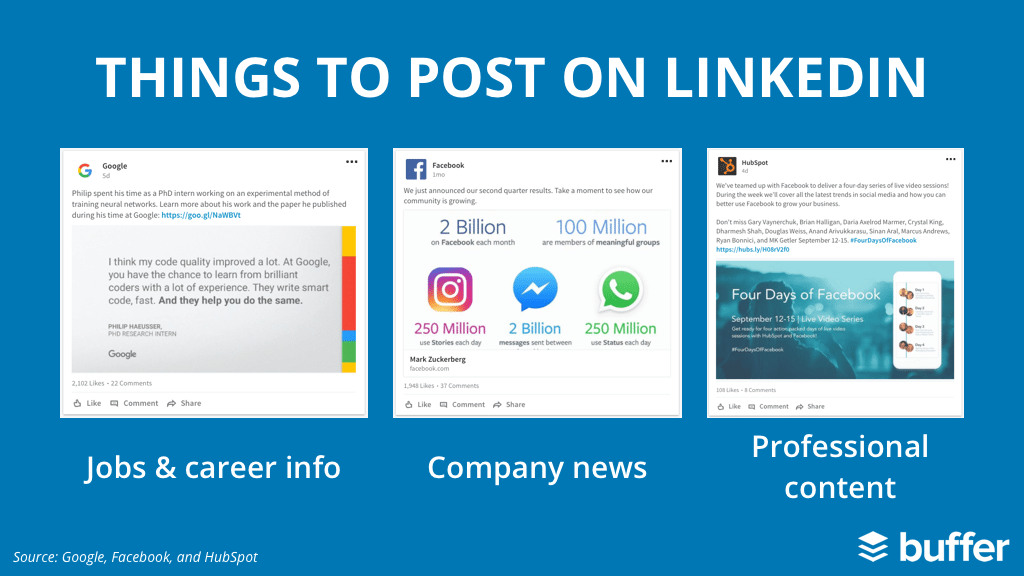
Jobs and career information
With LinkedIn being a professional networking platform, the most suitable content for LinkedIn is job listings and career information.
Your LinkedIn Company Page is a great channel for potential hires to learn more about your company. For example, Google uses their LinkedIn Company Page to showcase several things:
- their company culture
- their employees’ experiences working at Google
- their employees’ achievements
- their open job positions
It’s common to see posts like the one below on their Company Page.
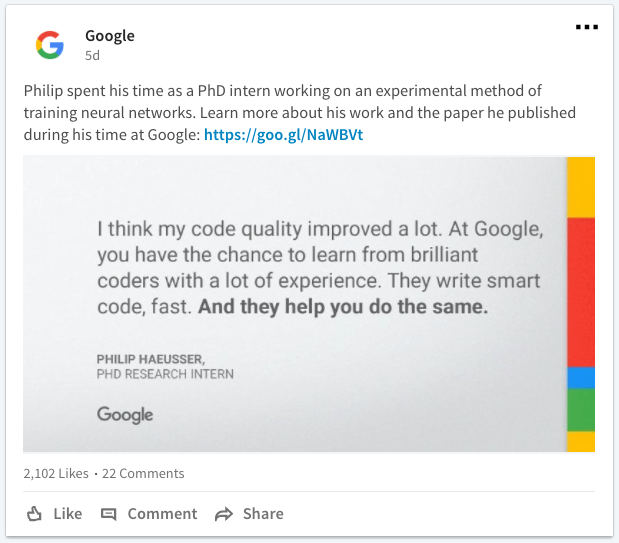
TIP:
If you would like to drive engagement on your LinkedIn posts, attach an image or video.
LinkedIn found that “images generally result in a 98% higher comment rate” and “links to YouTube videos play directly in the LinkedIn feed and usually result in a 75% higher share rate”.
Here are more best practices from LinkedIn on making your Company Page compelling.
Company news
Besides posting about job opportunities and career information, you can also share company news and milestones on your LinkedIn company page.
Here’s an example from Facebook:
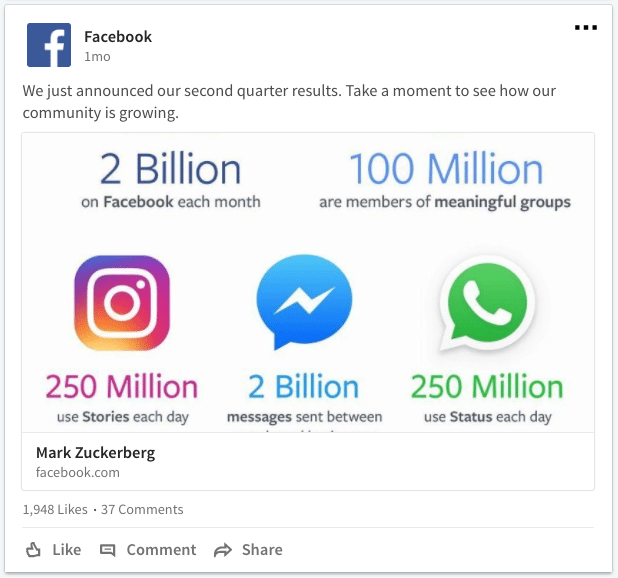
TIP:
Use the analytics for your Company Page to identify top posts, such as those with the highest impressions, clicks, or engagement rate, and figure out what resonates with your followers.
You can then create similar posts or repost those top posts a few weeks later.
Professional content
Sometimes, you might not have enough content about career or that many company news to share regularly on your Company Page. (We face this often.)
Another type of content you can share on LinkedIn is content that is relevant to the professionals in your target audience. This includes training webinars, whitepaper, and industry studies.
Here’s an example from HubSpot, who’s hosting a four-day series on using Facebook to grow a business:
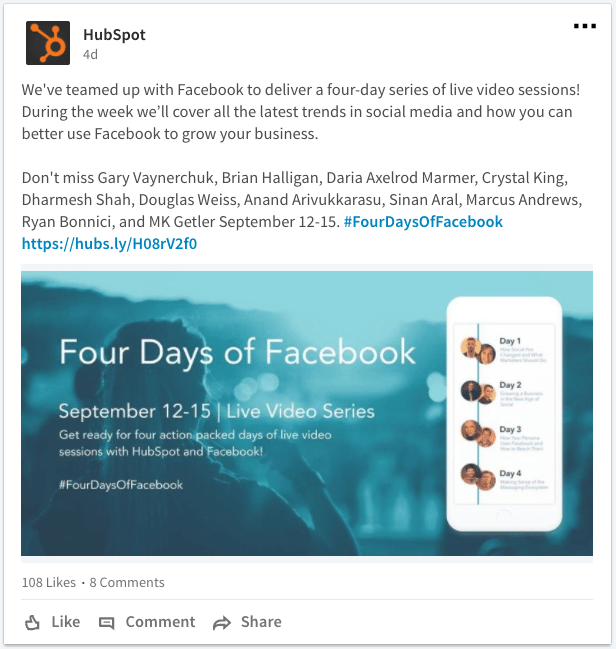
TIP:
You can learn about your followers’ demographics, such as job functions and industries, using the analytics for your Company Page. This way, you can have a better understanding of what professional content they might be most interested in.

What to post on Pinterest
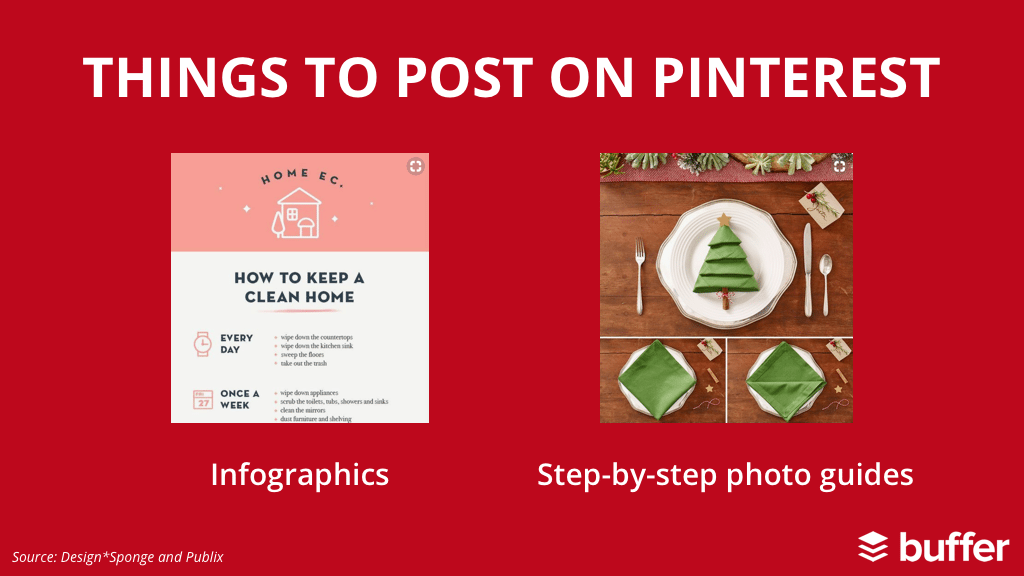
Infographics
Like Instagram, Pinterest is a very visual social media platform. So images are the best thing to post on Pinterest.
But unlike Instagram, images on Pinterest are mostly vertical. 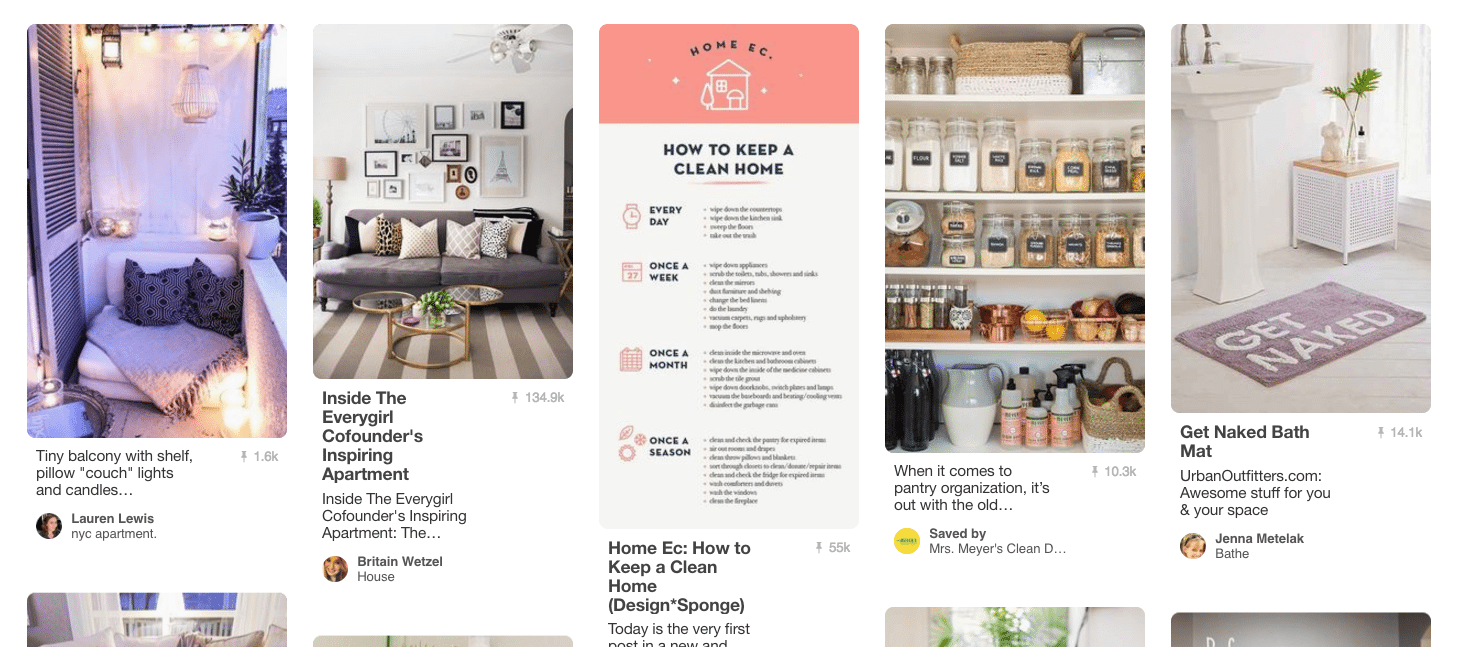
This layout makes Pinterest great for vertical images and infographics, such as this:

According to Pinterest, the best aspect ratio for Pinterest images is 2:3, with a minimum width of 600 pixels, such as 600 pixels wide by 900 pixels tall or 800 pixels wide by 1,200 pixels tall.
TIP:
Even if you aren’t a designer, it’s possible to create a basic infographic with graphic design tools like Piktochart and Venngage. Here are five more design tools you can use to create an infographic in 30 minutes.
Step-by-step photo guides
The most popular topics on Pinterest includes DIY and craft, home decor, food and drinks, and design.
Among these topics, vertical images with step-by-step photo instructions on how to make something perform really well.
Here’s one of the most popular pins for “napkin folding” (with over 400,000 re-pins):

Such guides teach people how to create something just through the photos, which makes them easy to consume and great for re-pin.
TIP:
If you are not sure what Pinterest image to create, do a search on Pinterest for the topic you’re interested in. Pinterest will show you some of the most popular pins for the topic, which you can refer to.

What to post on Google+
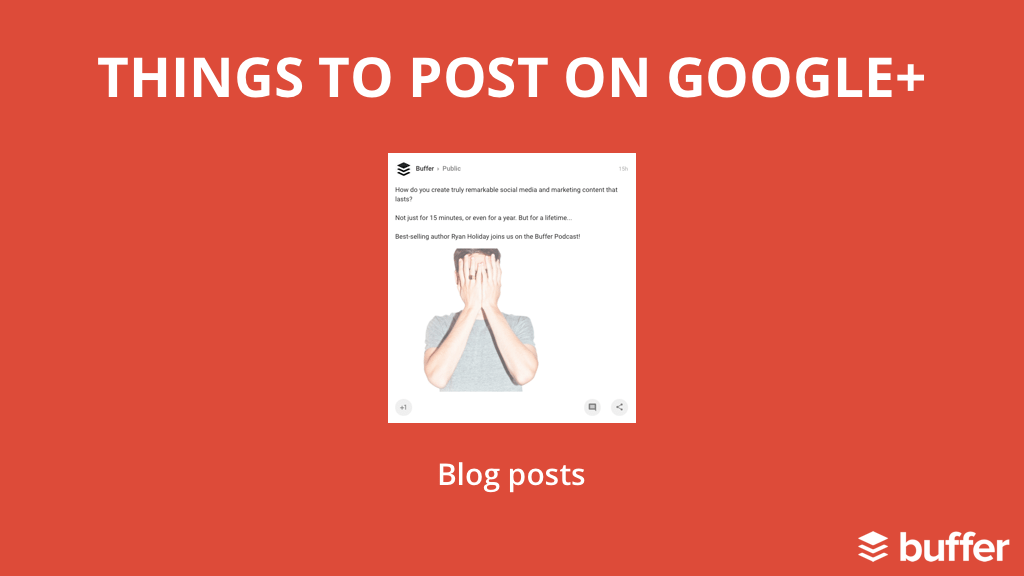
Blog posts
While Google+ is often overshadowed by other social media platforms, there are many reasons to consider Google+ in your marketing strategy.
What I personally like most is its SEO benefits.
We learned that content posted onto Google+ gets indexed immediately and shows up in search results soon after!
For example, when Patrick Antinozzi of Rapid Web Launch published his blog post on Pokemon Go, he shared it on Google+. Within an hour, his Google+ post appeared on the first page of Google search results for “pokemon go”.
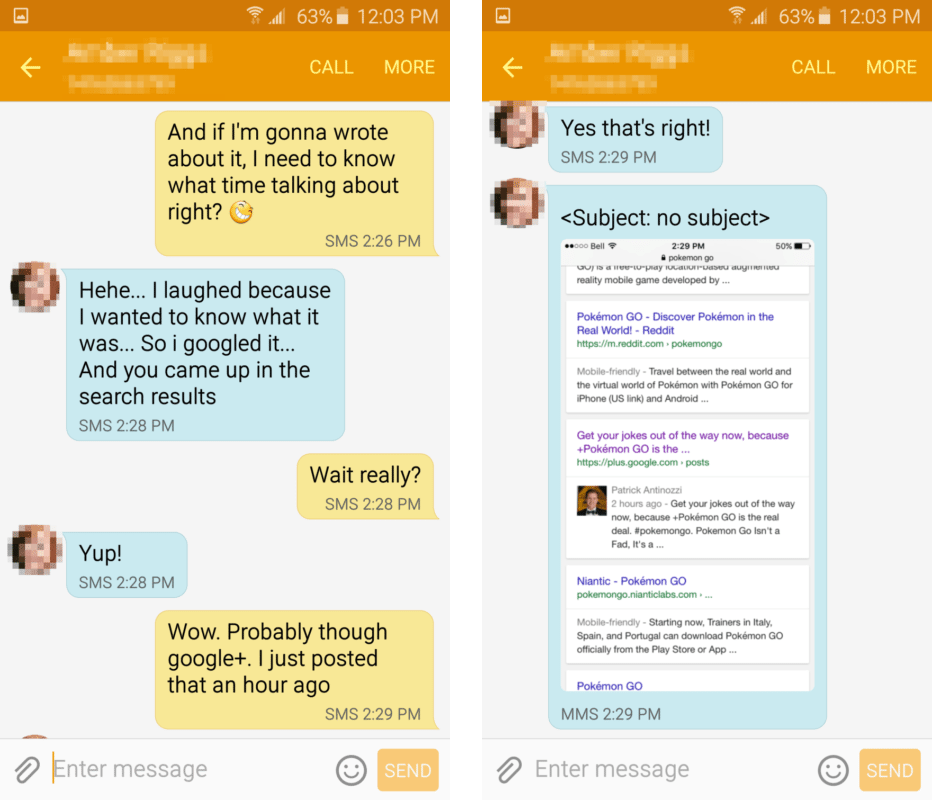
While we don’t see as much engagement on Google+ as Facebook, Twitter, and Instagram, I believe it’s still worthwhile sharing our blog posts on Google+ to help it get indexed by Google immediately.
TIPS:
Here are nine more tips for taking advantage of Google+ for SEO from Cyrus Shepard, founder of Fazillion and former Head of SEO & Content at Moz.
While this post is a little old, many of the tips are still relevant today — like the point above.

What do you post on each social media platform?
Since these are general guidelines, the types of content that would do well for you on each of the social media platforms might differ.
If you are open to sharing, I would love to learn from you. Which types of content have done well for you on the platforms mentioned above?
P.s. Once you have figured out what types of content to post on each of your social media accounts, here are some social media content ideas to help you.
—
Image credit: Unsplash





